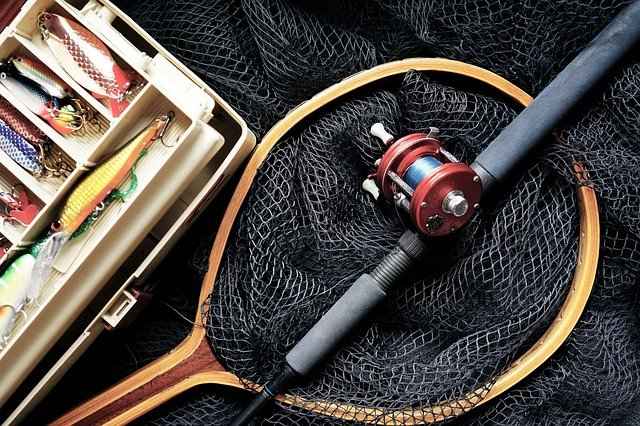It may be challenging to fish in rivers since rivers often have strong currents, which makes fishing in rivers quite different from fishing in calm and tranquil streams, lakes, and seas. This article will walk you through gathering the necessary equipment and developing skills on how to catch fish and the best way to catch fish in a river successfully.
Table of Contents
First Of all, get your fishing licence.
A fishing licence, sometimes known as a fishing permit, is a piece of paperwork or legislation that local governments use as an administrative or legal tool to control fishing. Licenses are one fisheries control method often used in Western nations. Depending on the country, these licences may be necessary for recreational or commercial fishing.
Anyone above the age of 12 who fishes for salmon, trout, freshwater fish, smelt, or eels in England, Wales, or the Border Esk region in Scotland is required by the government to have a rod licence. In addition, anyone who fishes in a non-estuarine stream, lake, or canal must obtain a permit from the owner of the fishing rights to the water body.
Register your boat for fishing

The Merchant Shipping (Fishing Boats) Act of 1883 established a distinct series of records for fishing boats and personnel. The Act required the captain to sign a crew agreement with each crew member and expanded the examination procedure for masters and mates. The NRO does not hold crew records.
The Merchant Shipping Act of 1894 strengthened existing regulations and mandated the registration of all British sea fishing vessels, regardless of size. The vessels were to be lettered and numbered (LN, GY, etc.) and have official documentation. At each port, customs officials recorded certificate information and the letter and number of the vessel in records.
Annual returns were transmitted to the registrar general (and are currently maintained by TNA). The registries include the vessel’s registration number, name, registration date, official number, tonnage, etc. There is also a description of the typical kind of fishing conducted by the vessel.
Port of King’s Lynn
- Registers of fishing vessels and transaction books for fishing vessels, 1942-1988 (six volumes – P/SH/L/17-22).
- Applications for the registration of fishing vessels, 1940-1956 (one collection – P/SH/W/3)
Port of Great Yarmouth
- Registers of fishing vessels and fishing vessel transaction ledgers, 1940-1956, 1985-1989 (five volumes – P/SH/Y/61-69)
Learn how to choose Bait.
Remember these suggestions when visiting your favorite tackle shop to ensure you leave with the appropriate bait.
Keep Size and Color in Mind
Choose the fish you want to attract, then match the bait to the fish’s natural prey. The fish you are attempting to capture may get alarmed by huge bait, ignoring little bait. Imitate the prey’s hue. The majority of the food that fish consume will be colored naturally. Brightly colored bait may be effective in specific offshore settings, but you might want to go with a subdued hue if you’re fishing in a lake.
Consider Location
When selecting the correct bait, remember where your favorite fishing spot is. While saltwater fish are more likely to strike live bait, freshwater fish are more likely to react to artificial bait. Since the fish you’re trying to attract will be drawn to bait on top of the water or below it, depth is another important consideration.
Think About the Weather
The day’s weather patterns influence fish behavior. Fish have keen weather senses and may feel changes in pressure. Fish will be lazy after a cold front, so it’s best to fish in the days before. Darker bait is preferable on chilly, gloomy days since the light below the surface will shift. Choose a light-coloured bait if there are warm, bright days in the forecast since they will result in more transparent water.
Think about the Season
Fishing is an all-year pastime, which is fortunate for fishermen. Water temperatures may fluctuate with the seasons, so be careful to modify your bait correctly. Any moving bait will work at any temperature, although slower moving baits, such as shaky heads, are needed in cooler water. In warmer seas, a bait that moves more quickly, such as a crankbait, is acceptable. Faster baits work well throughout the spring spawning season as well.
Learn how to set the Hook?
Although practice and time on the lake are necessary for improving your hookset technique, some essential components are also required for a successful hookset.

#1. Be patient and sense the fish’s weight
Possibly one of the most often used guidelines for creating a hook. In topwater fishing, this is especially true since the surface explosion sometimes causes fishermen to set the hook before the fish has even accepted the bait. Wait until you feel the weight before putting the hook when a fish strikes a topwater bait.
Nevertheless, every rule has an exception, and sometimes a fish’s weight won’t be felt when it hits. An excellent illustration is while using jigs for fishing. Several fish strike jigs as they descend. Watching the line on the surface for a tick or an early halt in the jig’s descent is the best course of action in this situation. In this case, reel in any slack line immediately, and once it is taut, set the hook.
#2. Time is of the essence
It may be the most significant flaw in how hooksets are described. A general rule of thumb is to set the hook quickly when going for aggressive fish attacking baits hard. On the other hand, it’s preferable to wait, let the fish accept the bait, and set the hook after you feel the weight of the fish if they are in a neutral or negative mood and just softly strike the bait.
#3. Remove any loose lines to guarantee good sets
I’ve previously hinted at this, but it’s a typical error. The line has to be kept tight at all times. The force of your hooksets is increased as well as your sensitivity and ability to sense hits while using the taut line. Maintaining a tight line makes it more likely that the hook will move along with your rod as you move it. A slack-line set merely mends the slack line rather than exerting much power on the hook. To make sure you are burying the hooks in the water, it is essential to reel in slack line before a set.
#4. Use live bait right away.
When using live bait, anglers that take too long to set the hook are often responsible for gut-hooked fish. Live bait is food that fish will consume if given a chance, unlike the strange taste of artificial lures, which they will immediately spit out once they discover they can’t eat them. Even though fish in neutral or bad moods seldom take bait aggressively, it’s preferable to set the hook sooner and lose the occasional fish or piece of bait than to wait too long and gut-hook to catch fish, which reduces the fish’s chances of surviving after release.
How to Cast?
Most beginners overthink how to catch the fish. But in all honesty, I believe there are just five steps involved in throwing a fishing rod. Casting will become second nature if appropriately done and often over time. During this procedure, we’ll assist in establishing the groundwork for later use of the more sophisticated lure fishing approaches. These stages also include operating a spinning rod and reel, most often used in the fishing industry.
Preparing to cast
We’ll position ourselves by holding the rod firmly before throwing it. The bail arm will then be released once we make a trigger by hooking the line with our pointer finger.
Examine your surroundings
Before casting, turn your head in the direction you wish to cast. While holding onto the line, check your surroundings for obstructions, such as other fishermen or objects. Once everyone is present, everything is free, and there is ample room. The rod will then be placed slightly beyond a 90-degree angle concerning your body. After letting go of the line with your pointer finger, we’ll swing the rod in the direction you wish to throw.
Narrow your line.
After the rig has submerged and reached the bottom of the sea, the bail arm will be folded down, and the line will be tightened until you can feel the strain. Maintain a tight line and feel for any bites.
Hooking the fish
As soon as you receive bites, quickly strike the rod, raise the rod, and hook to catch fish. Once the fish is caught, reel it slowly while maintaining a tight line to prevent unhooking it. Congratulations! You’ve just made your first cast and, hopefully, managed to net a fish.

What is used to catch a fish?
Continue reading to learn more about the current fishing equipment used nowadays.
Fishing rod
The fishing rod is a long, thin, flexible piece of equipment for capturing fish. You need this gadget to throw your fishing line farther into the water. For a specific style of fishing adventure, you may utilize a variety of fishing rods. They are constructed of graphite or fiberglass.
Fishing float
It’s time to search for a fishing reel now that you have a fishing rod and line. When you purchase the three tools from a sports fishing equipment store, they often come in a box. But if you’re picky about the tools you’ll use, you can buy them individually.
With the aid of a fishing reel, you may reel in your catch or prepare another casting of the hook and bait. The reel might be found at the pole’s base or around the handle.
Fish hook
The fish will be caught by the hook, allowing you to reel it with your fishing reel. The carefully crafted hook is intended to skew its jaws as the fish eats the bait. Move your fishing rod around until the fish loses strength if your catch doesn’t slip off the hook. Then, you may get it or use the reel to draw it in.
Floats and weights
After casting your fish hook into the water, the floats are a crucial tool for you to use to locate and gauge its depth. On the other hand, the weight will enable the hook to penetrate the water’s bottom farther, allowing you to capture fish. For efficient fishing, you need these supplies.
How to drag?
- It is simplest to test the drag on a spinning or spin cast reel by pulling on your line just above the reel with your hand.
- If the line comes out too readily, tighten the drag on your spinning wheel by moving the front drag adjustment button a few clicks to the right. Turn the crank a few clicks to the left to relax the drag if it’s too tight. An adjustment mechanism for the top set roller drag is often included in closed-face spincast versions.
- If you don’t feel that you can gauge the force precisely, a little spring scale, like those found in Boca Grips or other catch-and-release fish handling tools, may be useful. Hook the weight while angling your rod at 45 degrees. The drag setting should be chosen such that the line can support between a third and half of its weight before moving to get the optimum results.
- Instead of having it too tight and breaking off a large fish, it is preferable to have your drag set too loosely and battle a fish a bit longer.
How to cast a bait caster?
Follow these step-by-step instructions to practice bait caster fishing.
- Make sure your baitcasting reel matches your rod.
- Learn baitcasting with a thick line. 15 to 17-pound monofilament fishing line is the simplest to throw and prevents backlashes.
- Set the star drag and spool tension using the reel’s handbook.
- Hold your rod horizontally and gently push the thumb bar to drop your bait. This checks spool tension before casting.
- Put the rod over your shoulder before casting.
- Depress the thumb bar while holding the line spool. Depressing the thumb bar will release your line.
- Goal-strive.
- Apply tight pressure on the spool with your thumb as you start your throw to prevent overwinding (this will help you avoid a backlash), then gradually release the strain to feather out your line.
- Once you activate the anti-reverse, you may fish.
How to reel in fish?
Here, you must know fishing reel tactics, such as avoiding reeling in the line while the fish is swimming away. Other reel suggestions for beginners:
- Let the drag and rod operate. Keep the rod at a 45-degree angle to the water, point it at the fish, and reel until the drag stops buzzing.
- When the fish slows down and stops accepting the line, work harder. The pump-and-reel method is effective to catch fish.
- Lift the rod tip 90 degrees without reeling in the fish. A heavier fish will bend your fishing pole, but don’t panic.
- Keep equal pressure on the fish as you reel while lowering the rod to 45 degrees.
- Repeat this procedure.
How to land a Fish?
For the best possible chance of successful landings, adhere to the below steps.
- Drop your whole rod and reel to your waist as your fish approaches the boat.
- Get your rod tip in the water and pursue the fish if it dives beneath the boat.
- You can tell when a fish is weary if you can see it. When it’s ready to be landed, it will flip over on its side to signal you. You can feel the fish even if you cannot see it.
- For smaller fish, like crappie, just swiftly raise them from the water using your hands or a fishing net, then cradle the fish around the belly to remove the hook.
How to release a fish?
First, learn how to handle and release fish in a conservation-friendly way.
- Use damp hands or knotless landing nets while handling fish. This helps preserve the fish’s slime coat, which allows it to swim. Good catch-and-release anglers never use towels to manage fish because towels remove the slime covering.
- Fish usually swim horizontally, so hold them that way. Not on hard surfaces!
- Don’t touch the fish’s gills or eyes.
- Dehookers and recompression equipment may be used to reduce handling.
- It’s time-sensitive! When possible, return fish to the water as soon as possible. Head-first release helps drive water into the fish’s mouth and gills, reviving it. Place weary fish in the water with one hand beneath the belly and the other supporting the bottom lip or tail.
- Learn how to precisely measure fish to comply with state fishing rules. By obeying fishing restrictions, you’re preserving fish populations for future generations.
How do keep fish fresh?
Put the fish on ice.
Throughout the preparation, fish must be iced. Ice a fish after dressing it. Icing fish for shipping is preferable. Leave the drain plug on an insulated cooler open so the ice melts. Fish ruined by water.
Fridge the fish.
Fresh fish without freezing? How to keep newly caught fish in refrigerators. Wash and dry a fish before refrigerating it. Wrap the cleaned fish in waxed paper, plastic wrap, or aluminum foil and refrigerate it. Fish may be refrigerated for two days. Large fish or chunks last longer than little ones. Panfish and walleye are lean fish that are stored well (trout).
Freeze fish
Fish may also be frozen. Fish are frozen for 3-12 months. However, freezing seafood requires preparation. Air may make fish tasteless.
Conclusion:
Before venturing on the water, learn specific river fishing guidelines, including rod and equipment selection. Beginners should fish in summer. Important is education and practice. In this article, we discussed the advice on how to catch fish, and the best way to catch fish on rivers sides. I hope you find this article informative. Thank You for Reading the Entire Article!


